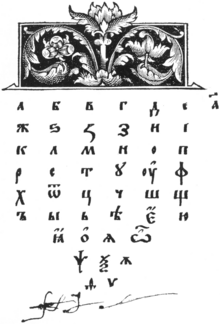
A | B | C | D | E | F | G | H | CH | I | J | K | L | M | N | O | P | Q | R | S | T | U | V | W | X | Y | Z | 0 | 1 | 2 | 3 | 4 | 5 | 6 | 7 | 8 | 9
This article needs additional citations for verification. (January 2023) |
| Cyrillic script | |
|---|---|
 1850s Romanian text (Lord's Prayer), written with the Cyrillic script | |
| Script type | |
Time period | Earliest variants exist c. 893[1] – c. 940 |
| Direction | Left-to-right |
| Official script | 7 sovereign states Co-official script in: 6[i] sovereign states and 2* disputed territories |
| Languages | See Languages using Cyrillic |
| Related scripts | |
Parent systems | Egyptian hieroglyphs[4]
|
Child systems | Old Permic script |
Sister systems | |
| ISO 15924 | |
| ISO 15924 | Cyrl (220), Cyrillic Cyrs (Old Church Slavonic variant) |
| Unicode | |
Unicode alias | Cyrillic |
| |
Names: Belarusian: кірыліца, Bulgarian: кирилица [ˈkirilit͡sɐ], Macedonian: кирилица , Russian: кириллица [kʲɪˈrʲilʲɪtsə], Serbian: ћирилица, Ukrainian: кирилиця [keˈrɪɫet͡sʲɐ] | |

The Cyrillic script (/sɪˈrɪlɪk/ sih-RIL-ik), Slavonic script or simply Slavic script is a writing system used for various languages across Eurasia. It is the designated national script in various Slavic, Turkic, Mongolic, Uralic, Caucasian and Iranic-speaking countries in Southeastern Europe, Eastern Europe, the Caucasus, Central Asia, North Asia, and East Asia, and used by many other minority languages.
As of 2019[update], around 250 million people in Eurasia use Cyrillic as the official script for their national languages, with Russia accounting for about half of them.[6] With the accession of Bulgaria to the European Union on 1 January 2007, Cyrillic became the third official script of the European Union, following the Latin and Greek alphabets.[7]
The Early Cyrillic alphabet was developed during the 9th century AD at the Preslav Literary School in the First Bulgarian Empire during the reign of Tsar Simeon I the Great, probably by the disciples of the two Byzantine brothers Cyril and Methodius, who had previously created the Glagolitic script. Among them were Clement of Ohrid, Naum of Preslav, Angelar, Sava and other scholars.[8][9][10][11] The script is named in honor of Saint Cyril.
Etymology
Since the script was conceived and popularised by the Slavic followers of Cyril and Methodius, rather than by Cyril and Methodius themselves.[12] Its name denotes homage rather than authorship.[13]
History


The Cyrillic script was created during the First Bulgarian Empire.[15] Modern scholars believe that the Early Cyrillic alphabet was created at the Preslav Literary School, the most important early literary and cultural center of the First Bulgarian Empire and of all Slavs:
Unlike the Churchmen in Ohrid, Preslav scholars were much more dependent upon Greek models and quickly abandoned the Glagolitic scripts in favor of an adaptation of the Greek uncial to the needs of Slavic, which is now known as the Cyrillic alphabet.[10]
A number of prominent Bulgarian writers and scholars worked at the school, including Naum of Preslav until 893; Constantine of Preslav; Joan Ekzarh (also transcr. John the Exarch); and Chernorizets Hrabar, among others. The school was also a center of translation, mostly of Byzantine authors. The Cyrillic script is derived from the Greek uncial script letters, augmented by ligatures and consonants from the older Glagolitic alphabet for sounds not found in Greek. Glagolitic and Cyrillic were formalized by the Byzantine Saints Cyril and Methodius and their Bulgarian disciples, such as Saints Naum, Clement, Angelar, and Sava. They spread and taught Christianity in the whole of Bulgaria.[16][17][18][19] Paul Cubberley posits that although Cyril may have codified and expanded Glagolitic, it was his students in the First Bulgarian Empire under Tsar Simeon the Great that developed Cyrillic from the Greek letters in the 890s as a more suitable script for church books.[15]
| History of the alphabet | ||
|---|---|---|
|
||
|
||
Cyrillic spread among other Slavic peoples, as well as among non-Slavic Romanians. The earliest datable Cyrillic inscriptions have been found in the area of Preslav, in the medieval city itself and at nearby Patleina Monastery, both in present-day Shumen Province, as well as in the Ravna Monastery and in the Varna Monastery. The new script became the basis of alphabets used in various languages in Orthodox Church-dominated Eastern Europe, both Slavic and non-Slavic languages (such as Romanian, until the 1860s). For centuries, Cyrillic was also used by Catholic and Muslim Slavs (see Bosnian Cyrillic).
Cyrillic and Glagolitic were used for the Church Slavonic language, especially the Old Church Slavonic variant. Hence expressions such as "И is the tenth Cyrillic letter" typically refer to the order of the Church Slavonic alphabet; not every Cyrillic alphabet uses every letter available in the script. The Cyrillic script came to dominate Glagolitic in the 12th century.
The literature produced in Old Church Slavonic soon spread north from Bulgaria and became the lingua franca of the Balkans and Eastern Europe.[20][21][22][23][24]
Bosnian Cyrillic, widely known as Bosančica[25][26] is an extinct variant of the Cyrillic alphabet that originated in medieval Bosnia. Paleographers consider the earliest features of Bosnian Cyrillic script had likely begun to appear between the 10th or 11th century, with the Humac tablet (a tablet written in Bosnian Cyrillic) to be the first such document using this type of script and is believed to date from this period.[27] Bosnian Cyrillic was used continuously until the 18th century, with sporadic usage even taking place in the 20th century.[28]
With the orthographic reform of Saint Evtimiy of Tarnovo and other prominent representatives of the Tarnovo Literary School of the 14th and 15th centuries, such as Gregory Tsamblak and Constantine of Kostenets, the school influenced Russian, Serbian, Wallachian and Moldavian medieval culture. This is known in Russia as the second South-Slavic influence.
In 1708–10, the Cyrillic script used in Russia was heavily reformed by Peter the Great, who had recently returned from his Grand Embassy in Western Europe. The new letterforms, called the Civil script, became closer to those of the Latin alphabet; several archaic letters were abolished and several new letters were introduced designed by Peter himself. Letters became distinguished between upper and lower case. West European typography culture was also adopted.[29] The pre-reform letterforms, called 'Полуустав', were notably retained in Church Slavonic and are sometimes used in Russian even today, especially if one wants to give a text a 'Slavic' or 'archaic' feel.
The alphabet used for the modern Church Slavonic language in Eastern Orthodox and Eastern Catholic rites still resembles early Cyrillic. However, over the course of the following millennium, Cyrillic adapted to changes in spoken language, developed regional variations to suit the features of national languages, and was subjected to academic reform and political decrees. A notable example of such linguistic reform can be attributed to Vuk Stefanović Karadžić, who updated the Serbian Cyrillic alphabet by removing certain graphemes no longer represented in the vernacular and introducing graphemes specific to Serbian (i.e. Љ Њ Ђ Ћ Џ Ј), distancing it from the Church Slavonic alphabet in use prior to the reform. Today, many languages in the Balkans, Eastern Europe, and northern Eurasia are written in Cyrillic alphabets.
Letters
Cyrillic script spread throughout the East Slavic and some South Slavic territories, being adopted for writing local languages, such as Old East Slavic. Its adaptation to local languages produced a number of Cyrillic alphabets, discussed below.
| А | Б | В | Г | Д | Є | Ж | Ꙃ[32] | Ꙁ | И | І | К | Л | М | Н | О | П | Р | С | Т | Ꙋ | ОУ[33] | Ф |
| Х | Ѡ | Ц | Ч | Ш | Щ | Ъ | ЪІ[34] | Ь | Ѣ Ҍ | Ꙗ | Ѥ | Ю | Ѫ | Ѭ | Ѧ | Ѩ | Ѯ | Ѱ | Ѳ | Ѵ | Ҁ[35] |
Capital and lowercase letters were not distinguished in old manuscripts.

Yeri (Ы) was originally a ligature of Yer and I (Ъ + І = Ы). Iotation was indicated by ligatures formed with the letter І: Ꙗ (not an ancestor of modern Ya, Я, which is derived from Ѧ), Ѥ, Ю (ligature of І and ОУ), Ѩ, Ѭ. Sometimes different letters were used interchangeably, for example И = І = Ї, as were typographical variants like О = Ѻ. There were also commonly used ligatures like ѠТ = Ѿ.
The letters also had numeric values, based not on Cyrillic alphabetical order, but inherited from the letters' Greek ancestors.[citation needed]
| 1 | 2 | 3 | 4 | 5 | 6 | 7 | 8 | 9 |
| А | В | Г | Д | Є (Е) | Ѕ (Ꙃ, Ꙅ) | З (Ꙁ) | И | Ѳ |
| 10 | 20 | 30 | 40 | 50 | 60 | 70 | 80 | 90 |
| І (Ї) | К | Л | М | Н | Ѯ (Ч) | Ѻ (О) | П | Ч (Ҁ) |
| 100 | 200 | 300 | 400 | 500 | 600 | 700 | 800 | 900 |
| Р | С | Т | Ѵ (Ѵ, Оу, Ꙋ) | Ф | Х | Ѱ | Ѡ (Ѿ, Ꙍ) | Ц (Ѧ) |
The early Cyrillic alphabet is difficult to represent on computers. Many of the letterforms differed from those of modern Cyrillic, varied a great deal in manuscripts, and changed over time. Few computer fonts include glyphs sufficient to reproduce the alphabet in its entirety. In accordance with Unicode policy, the standard does not include letterform variations or ligatures found in manuscript sources unless they can be shown to conform to the Unicode definition of a character: this aspect is the responsibility of the typeface designer.
The Unicode 5.1 standard, released on 4 April 2008, greatly improved computer support for the early Cyrillic and the modern Church Slavonic language. In Microsoft Windows, the Segoe UI user interface font is notable for having complete support for the archaic Cyrillic letters since Windows 8.[citation needed]
Currency signs
Some currency signs have derived from Cyrillic letters:
- The Ukrainian hryvnia sign (₴) is from the cursive minuscule Ukrainian Cyrillic letter He (г).
- The Russian ruble sign (₽) from the majuscule Р.
- The Kyrgyzstani som sign (⃀) from the majuscule С (es)
- The Kazakhstani tenge sign (₸) from Т
- The Mongolian tögrög sign (₮) from Т
Letterforms and type design
The development of Cyrillic letter forms passed directly from the medieval stage to the late Baroque, without a Renaissance phase as in Western Europe. Late Medieval Cyrillic letters (categorized as vyaz' and still found on many icon inscriptions today) show a marked tendency to be very tall and narrow, with strokes often shared between adjacent letters.
Peter the Great, Tsar of Russia, mandated the use of westernized letter forms (ru) in the early 18th century.[citation needed] Over time, these were largely adopted in the other languages that use the script. Thus, unlike the majority of modern Greek typefaces that retained their own set of design principles for lower-case letters (such as the placement of serifs, the shapes of stroke ends, and stroke-thickness rules, although Greek capital letters do use Latin design principles), modern Cyrillic types are much the same as modern Latin types of the same typeface family. The development of some Cyrillic computer fonts from Latin ones has also contributed to a visual Latinization of Cyrillic type.
Zdroj:https://en.wikipedia.org?pojem=Cyrillic_script
Text je dostupný za podmienok Creative Commons Attribution/Share-Alike License 3.0 Unported; prípadne za ďalších podmienok. Podrobnejšie informácie nájdete na stránke Podmienky použitia.
Antropológia
Aplikované vedy
Bibliometria
Dejiny vedy
Encyklopédie
Filozofia vedy
Forenzné vedy
Humanitné vedy
Knižničná veda
Kryogenika
Kryptológia
Kulturológia
Literárna veda
Medzidisciplinárne oblasti
Metódy kvantitatívnej analýzy
Metavedy
Metodika
Text je dostupný za podmienok Creative
Commons Attribution/Share-Alike License 3.0 Unported; prípadne za ďalších
podmienok.
Podrobnejšie informácie nájdete na stránke Podmienky
použitia.
www.astronomia.sk | www.biologia.sk | www.botanika.sk | www.dejiny.sk | www.economy.sk | www.elektrotechnika.sk | www.estetika.sk | www.farmakologia.sk | www.filozofia.sk | Fyzika | www.futurologia.sk | www.genetika.sk | www.chemia.sk | www.lingvistika.sk | www.politologia.sk | www.psychologia.sk | www.sexuologia.sk | www.sociologia.sk | www.veda.sk I www.zoologia.sk
